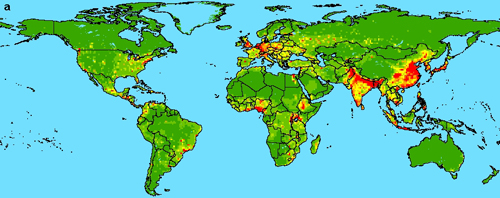
Oops. More of those unforeseen consequences. Including the first scientific evidence that deadly emerging diseases have risen steeply across the world. Why? Because of human expansion into shrinking pockets of biodiversity and resulting contacts with wildlife (think poor countries). Plus, the bonus factor (think rich countries), new diseases arising from overuse of antibiotics, centralized food processing, and other technologies, nursing other outbreaks, like multidrug-resistant pathogen strains. The study appears in the Feb. 21 issue of the scientific journal Nature.
In the new study, researchers from four institutions analyzed 335 emerging diseases from 1940 to 2004, then converted the results into maps correlated with human population density, population changes, latitude, rainfall and wildlife biodiversity. Disease emergences have quadrupled in 50 years. Sixty percent travelled from animals to humans, most from wild creatures. Hot spots on the map span sub-Saharan Africa, India, and China, with smaller spots in Europe, North America, and South America. Translated: everywhere.
Still waiting for human intelligence to overrule human appetite.
Julia Whitty is Mother Jones’ environmental correspondent, lecturer, and 2008 winner of the John Burroughs Medal Award. You can read from her new book, The Fragile Edge, and other writings, here.












